It‘s super easy to make authentic and homemade Japanese Miso Soup! In this recipe, I show you how to make quick and easy soup stock (dashi) from scratch, then create classic miso soup with tofu and wakame seaweed. It‘s delicious and has many health benefits.
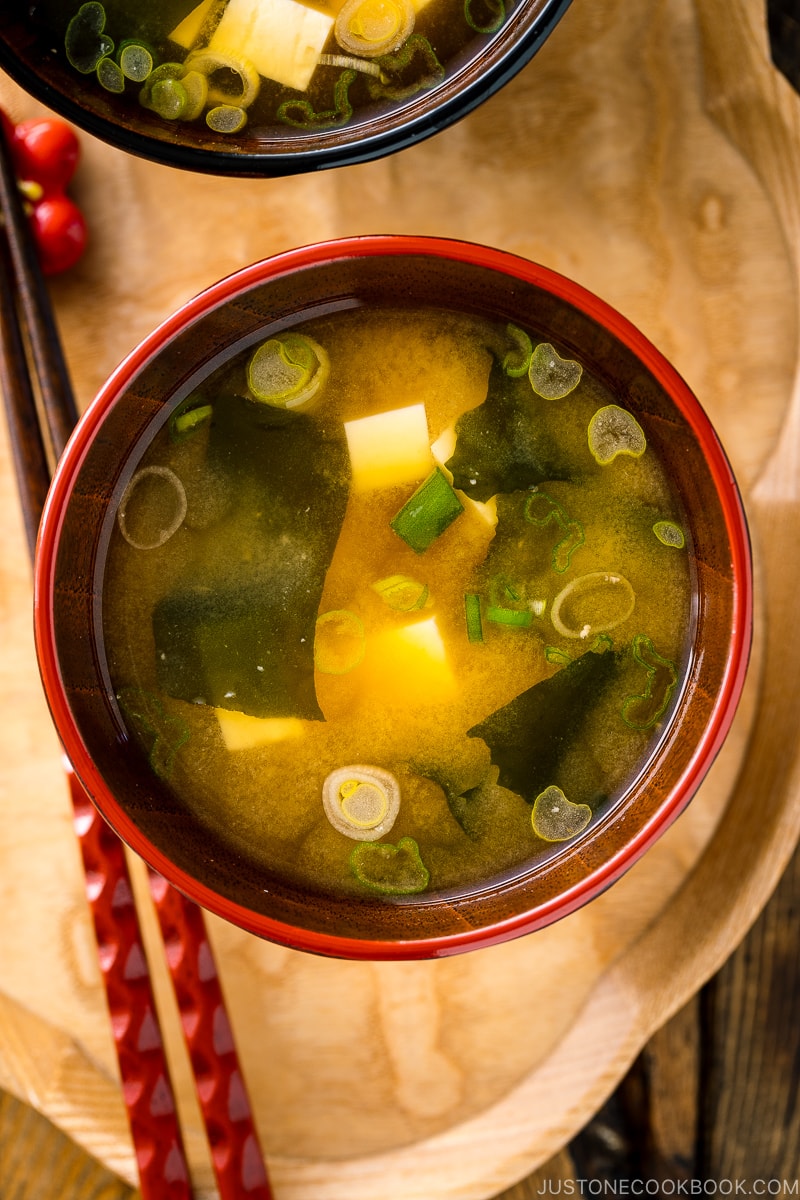
Miso soup is a staple in Japanese cuisine and is soup for the soul. We enjoy it almost every single day for breakfast, lunch, or dinner. As a Japanese home cook, I would also say that miso soup is probably one of the easiest soups you can make at home.
There are many paths to making miso soup, but once you grasp the basics, you can explore and customize. This post aims to equip you with all the essential knowledge to make yourself a bowl of authentic miso soup at home any time of the day. And trust me, what you make will taste 10,000 times better than the miso soup from Japanese restaurants or the instant varieties.
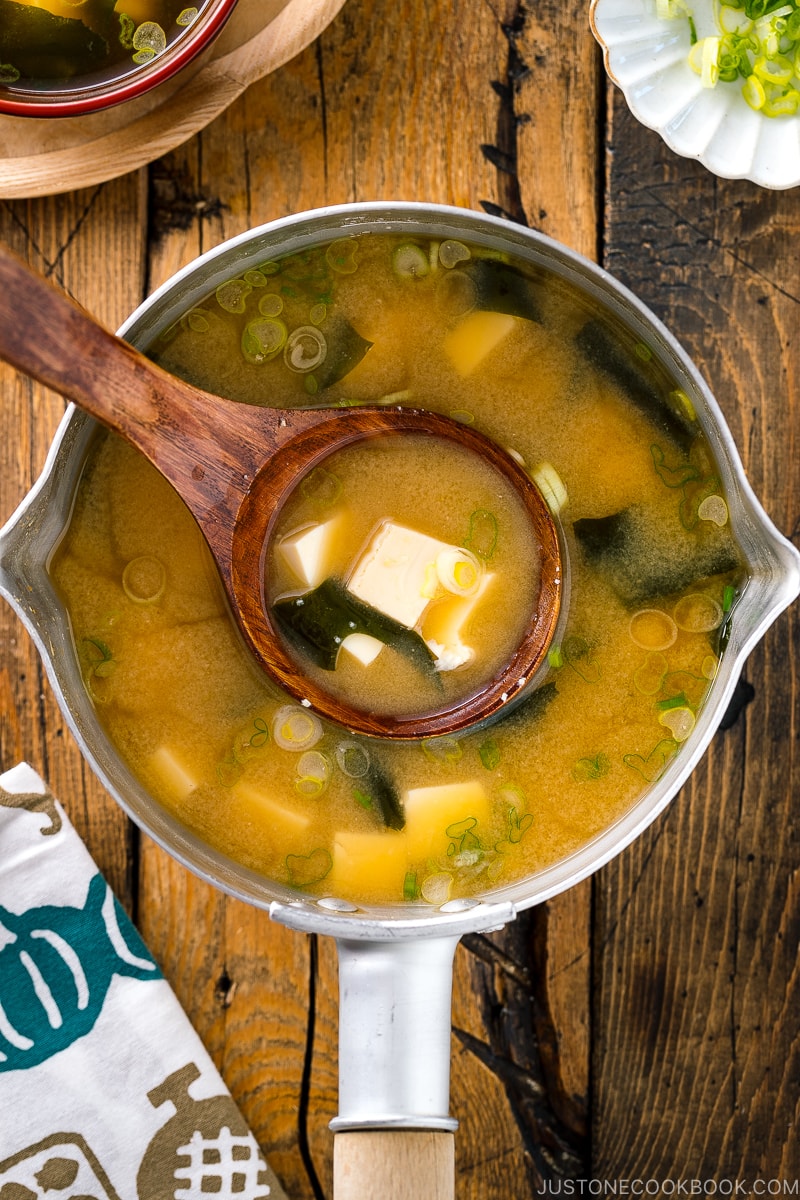
Table of Contents
- Best Miso Soup Recipe
- 3 Simple Steps to Make Miso Soup
- What is Dashi?
- How to Make Dashi
- Best Miso Paste for Miso Soup
- How Much Miso Paste to Add to the Soup?
- How to Dissolve Miso
- When to Add Tofu to the Soup
- Reheating Miso Soup
- How to Store Miso Soup
- Key Points to Remember
- Advanced: Incorporating Other Ingredients in Miso Soup
- Health Benefits of Miso Soup
- Popular Miso Soup Recipes
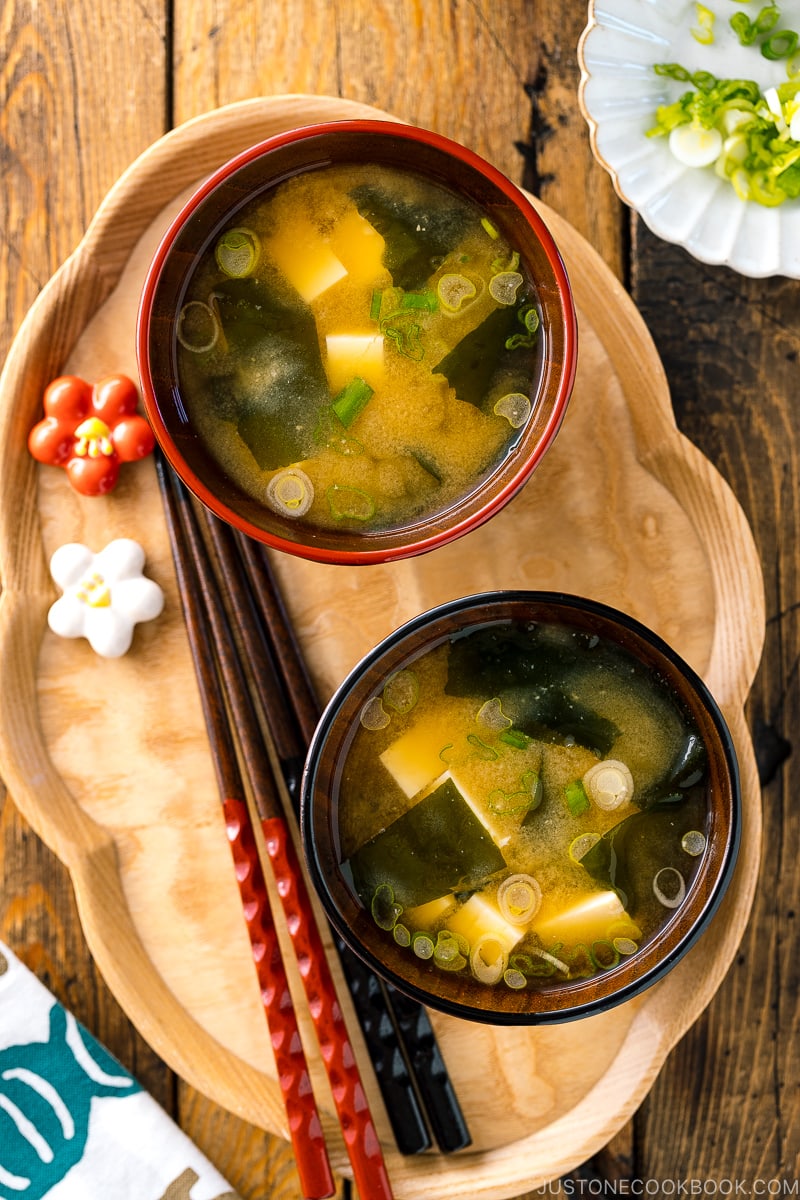
Best Miso Soup Recipe
Most Japanese meals are served with a small bowl of steamed rice and a traditional Japanese soup called Miso Soup or Misoshiru (味噌汁). At its most basic, miso soup is simply made of three components:
- Dashi (Japanese soup stock)
- Miso (Japanese soybean paste)
- Soup ingredients of your choice, such as tofu and wakame seaweed
Depending on the region, season, and personal preference, we can make many kinds of miso soup. In addition to the classic tofu and wakame combination I’ll show you today, we also use different savory ingredients such as root and leafy vegetables, meat, and seafood to enhance the soup. That’s why we can never get bored with it.
In this post, I will guide you through the most authentic miso soup recipe and explain how it all comes together in detail.
If you are already familiar with making miso soup, check out my Seasonal Miso Soup Recipe Collection.
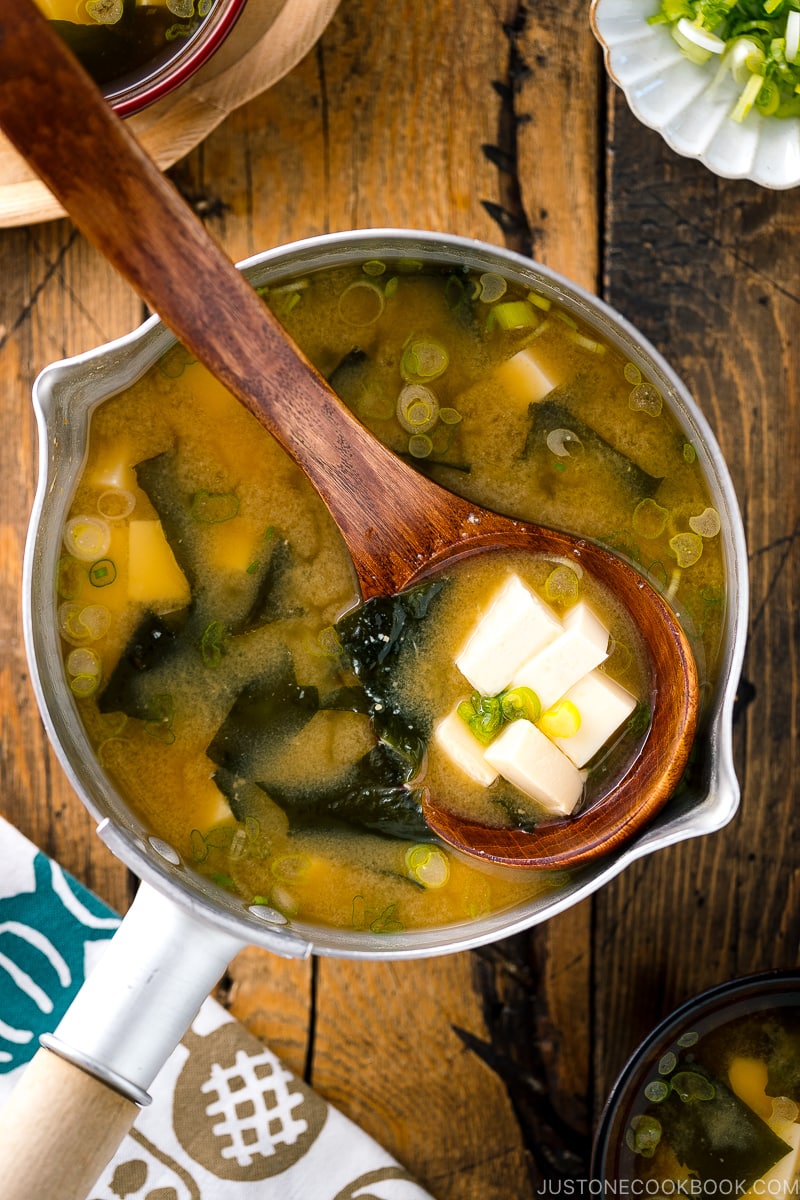
3 Simple Steps to Make Miso Soup
Making miso soup is simple, easy, and quick! Let’s master the basic miso soup with tofu and wakame seaweed. Here is the overview of the three steps:
- Make dashi (Japanese soup stock) [20 minutes]
- Add miso [2 minutes]
- Add tofu and wakame and serve [3 minutes]
Once you know how to make this classic Japanese miso soup, you can easily create endless variations by changing the ingredients.
Now let’s dive into each step.
What is Dashi?
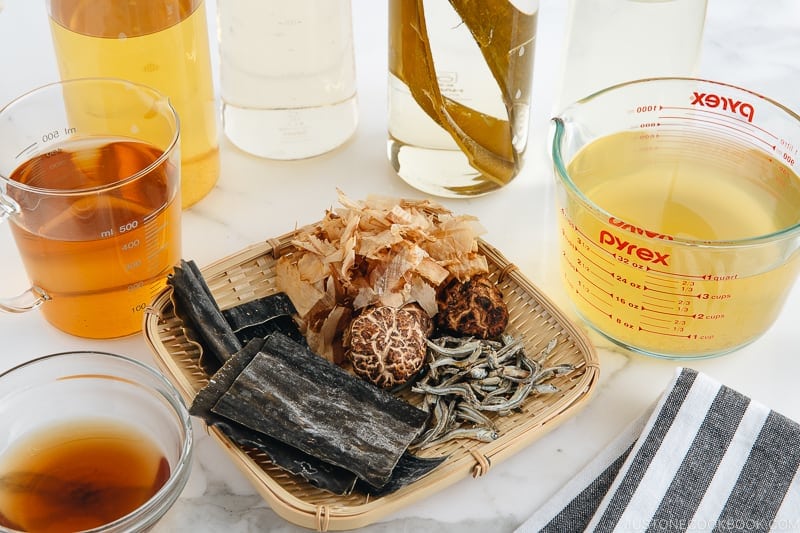
Dashi (だし・出汁) is a Japanese soup stock and the base of many Japanese dishes. It is the easiest and quickest broth to make. To make authentic Japanese miso soup, you must use dashi as the soup broth and not chicken stock or vegetable stock. Remember, without dashi, it’s not miso soup.
The most common and basic dashi is Awase Dashi, which is made with kombu (kelp) + katsuobushi (dried bonito flakes). Another popular dashi used for miso soup in Japan is Iriko Dashi, made with anchovies.
💡Pro Tip
If you’re vegetarian or vegan, you can use Kombu Dashi (made with kombu) or Vegan Dashi (made with kombu and dried shiitake mushrooms).
Also, did you know there are 6 different types of dashi that you can choose from? Check out The Ultimate Dashi Guide to learn more.
How to Make Dashi
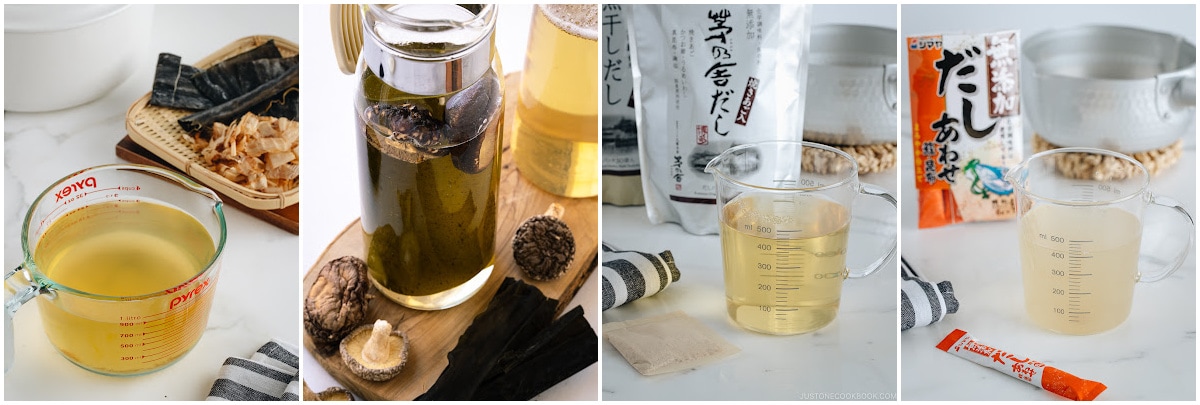
In general, there are three ways to make dashi.
- Homemade dashi — You can make a basic Awase Dashi from scratch by steeping kombu (edible kelp) and katsuobushi (dried bonito flakes) in water. If you’re vegetarian/vegan, use Kombu Dashi or make Vegan Dashi with kombu and dried shiitake mushrooms.
- Dashi packet — The dashi packet is the best shortcut method that I use often. Similar to making tea, you steep the dashi packet in water and cook for a couple of minutes. Despite its quick method, the flavor of dashi is pretty good.
- Dashi powder — Dashi powder (dashi granules) is my least favorite method due to its lack of flavor. The flavor and fragrance do not last long. But you can make a quick dashi with just dashi powder and hot water.
In this recipe, I’ll show you how to make both Kombu Dashi (vegan-friendly) and Awase Dashi from scratch!
💡Pro Tip
We use dashi in many Japanese recipes to incorporate umami. You can make a big batch of dashi and store it in the refrigerator for up to 3-5 days or in the freezer for two weeks. Use dashi for different recipes throughout the week. With dashi on hand, you can make the basic miso soup in under 5 minutes!
Best Miso Paste for Miso Soup
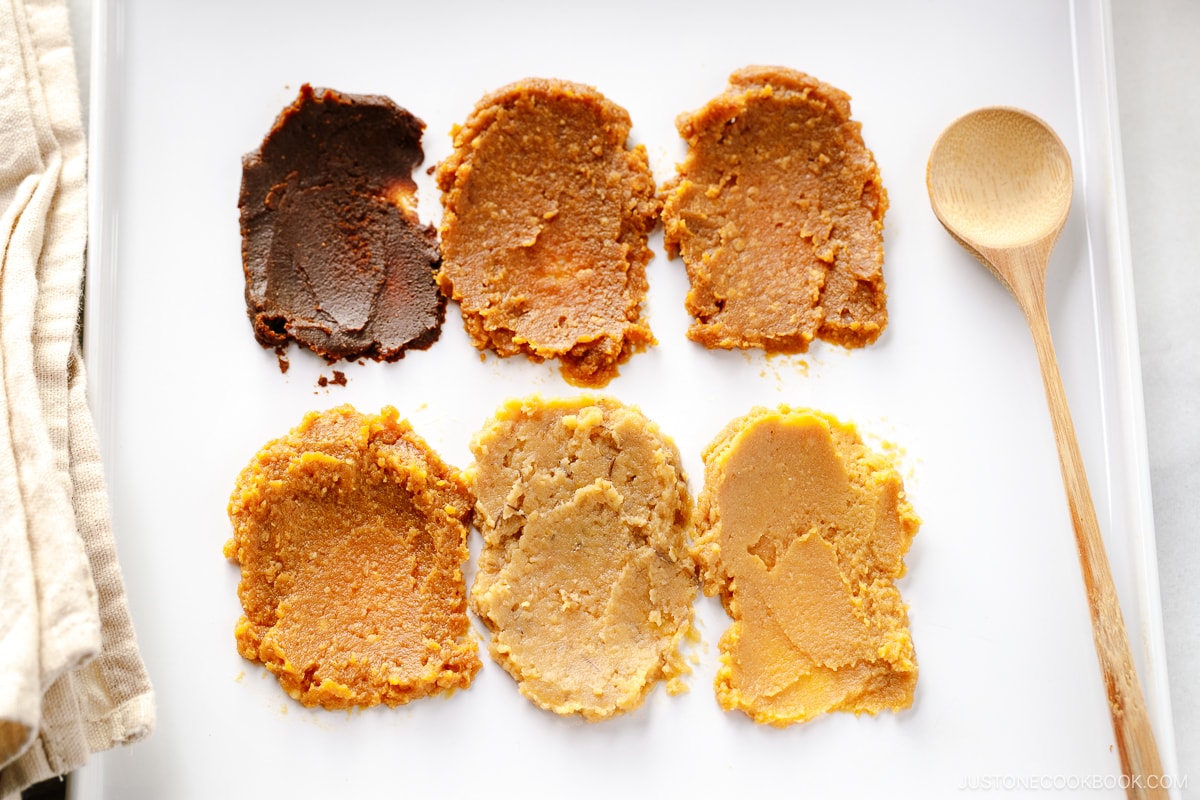
Miso (味噌) or fermented soybean paste is made from soybeans, grains (steamed rice or barley), salt, and koji culture (麹, a fermentation starter).
There are many different types of miso in the market. In the US, most miso available at mainstream grocery stores goes by colors, such as white miso (shiro miso), red miso (aka miso), and yellow miso (awase miso or mixed miso). If you want to learn more about miso, check out our detailed post.
Each miso paste and brand varies in saltiness and flavor. When it comes to miso soup, there is no “right” miso for your miso soup. Taste and adjust the miso amount. You can mix two to three miso brands/types for more complex flavors or enjoy its unique characters using just one type, especially if you have good-quality miso.

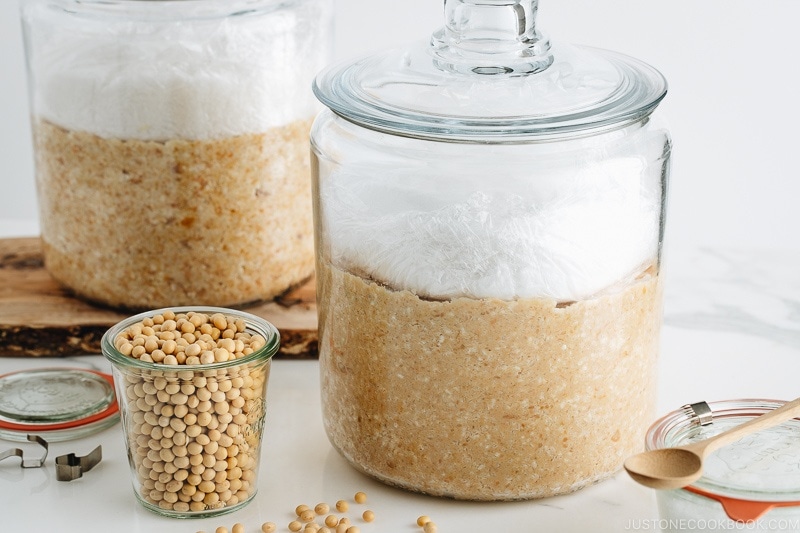
My favorite miso is this Kodawattemasu from Hikari Miso (organic slow-aged red koji miso). It has a more rounded character that goes well with any ingredients. If you want to make miso from scratch, check out How to Make Homemade Miso post.
💡Pro Tip
Dashi-included miso (だし入り味噌) may seem convenient as you don’t need to prepare dashi; however, you can’t expect to enjoy the same health benefits from it. To maintain quality and taste while preventing the container’s expansion, the manufacturer has to add additives and sterilize it by heating, which stops the action of yeasts. Therefore, I don’t recommend opting for dashi-included miso.
How Much Miso Paste to Add to the Soup?
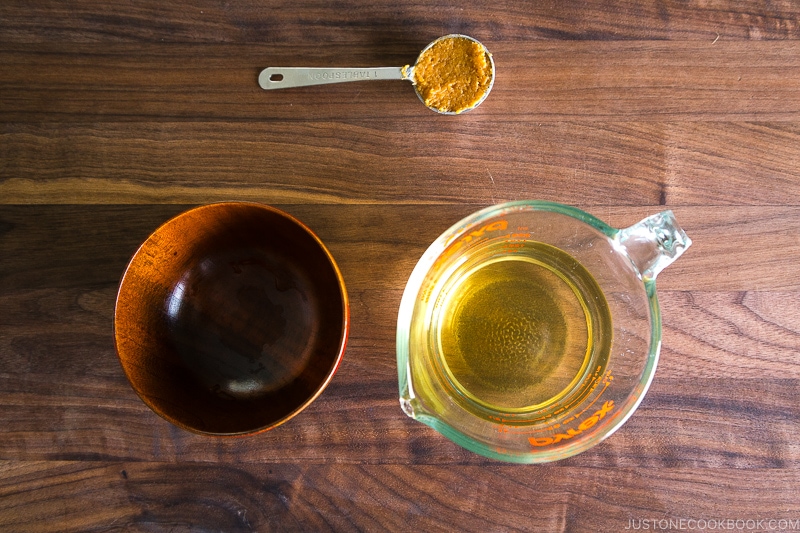
A general rule of thumb in Japan is to add one tablespoon (18 g) of miso paste per miso soup bowl, which holds 200 ml of dashi.
If you are using a US cup, use one tablespoon of miso per cup (240 ml) and add more after tasting it.
💡Pro Tip
When you are trying out a new miso, always start with less than the “one tablespoon per miso soup bowl” rule.
How to Dissolve Miso
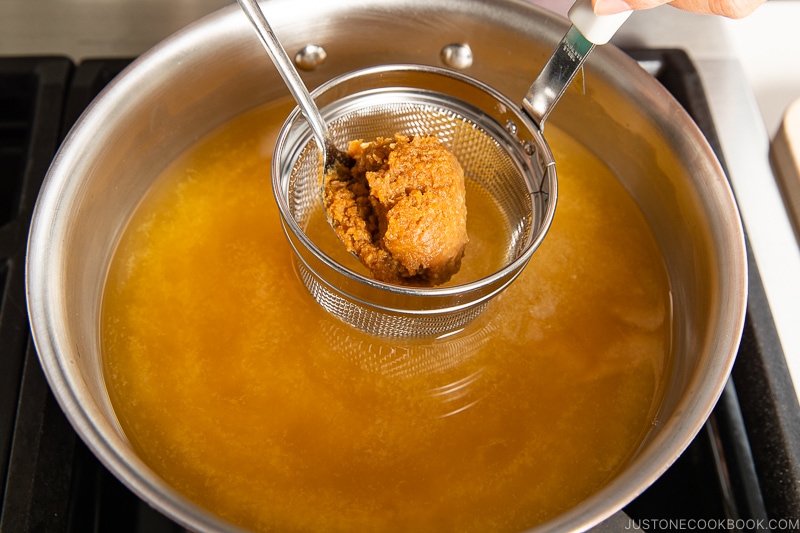
Make sure to turn off the stove’s heat so you don’t accidentally boil the miso soup. Always dissolve miso paste first in a ladle, a separate bowl, or a strainer, and never add miso paste directly to the soup! Otherwise, you may find miso clumps while drinking the soup!

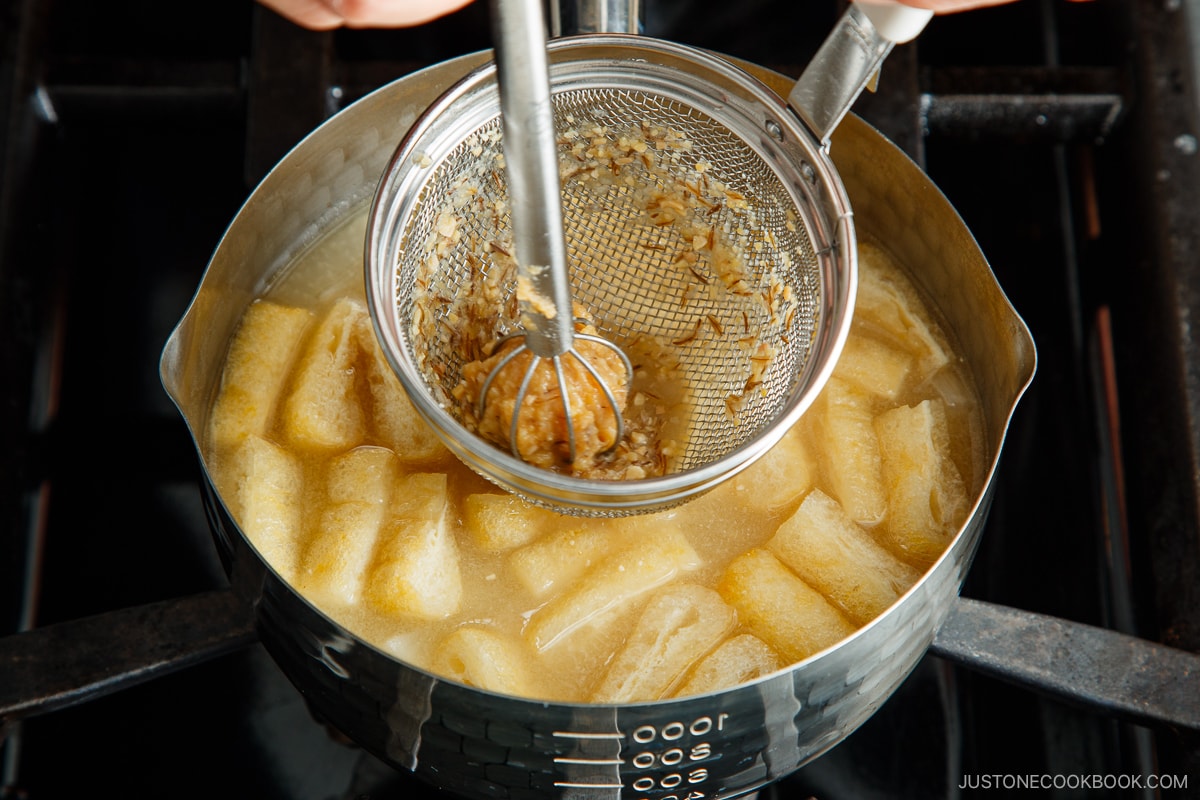
You can get my favorite Miso Muddler (One side of the whisk measures 2 Tbsp and the other 1 Tbsp) and a fine-mesh strainer to help dissolve miso.
💡Pro Tip
Add miso paste to dashi right before serving. Why? It’s to savor miso’s best flavor and aroma! Miso will lose its flavor and aroma if you keep reheating the miso soup.
Before adding miso, make sure to bring dashi to a slow boil (205°F/96°C). This temperature is considered the most fragrant stage for miso soup. By the time you are ready to enjoy the soup, it is at an ideal temperature (167ºF or 75ºC) for drinking.
When to Add Tofu to the Soup
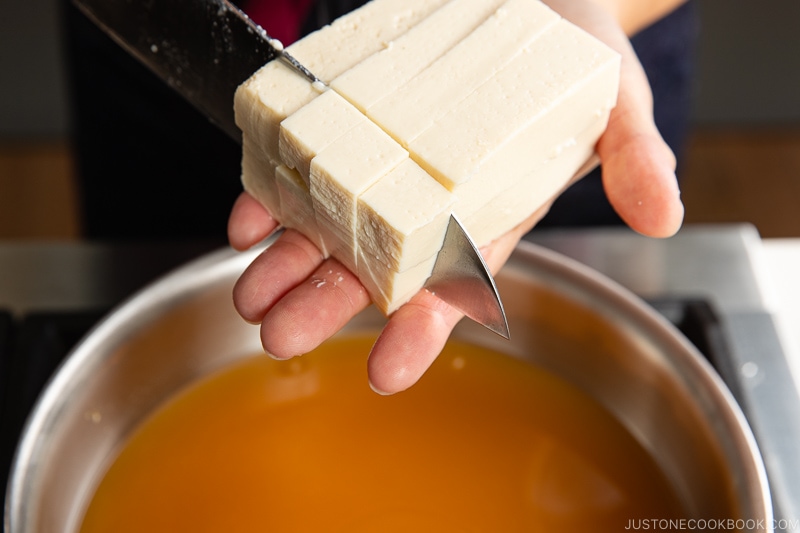
How about the tofu? We always add tofu after dissolving miso. This way, you won’t accidentally break up the tofu while mixing in the miso paste. Besides tofu, dried wakame seaweed and green onions are also added at the same time.

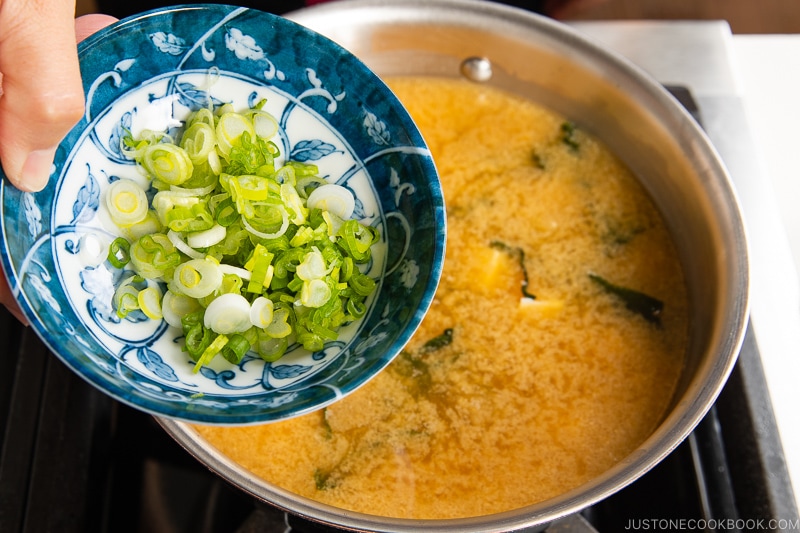
Tofu warms up nicely with the remaining heat (unless you put a lot of it) as it doesn’t require “cooking” it. (Did you know it’s edible out of the package? Try Chilled Tofu and Tofu Salad recipes!) Be careful, when you overheat tofu, the water content inside the tofu will seep out, resulting in hardened tofu.
After adding tofu, wakame seaweed, and green onion, serve miso soup immediately while it’s warm. By the time you are ready to enjoy the soup, it is an ideal temperature (167ºF or 75ºC) for drinking.
Types of tofu: You may wonder what type of tofu works best for miso soup. There is a misconception that you have to use silken/soft tofu for miso soup, but that’s not true.
You can use silken or soft tofu (kinugoshi tofu 絹ごし豆腐) for a custardy texture and medium to medium-firm tofu (momen tofu 木綿豆腐) for a spongy texture. In Japan, silken tofu is a slightly more popular choice than medium tofu, but both types of tofu are equally used in miso soup.
💡Pro Tip
Did you know it is common to cut tofu on your palm in Japan? You might have seen it in Japanese dramas or animes. I recommend using a cutting board if you have never done this. The typical tofu size in miso soup is ½ inch (1.3 cm) cubes.
Reheating Miso Soup
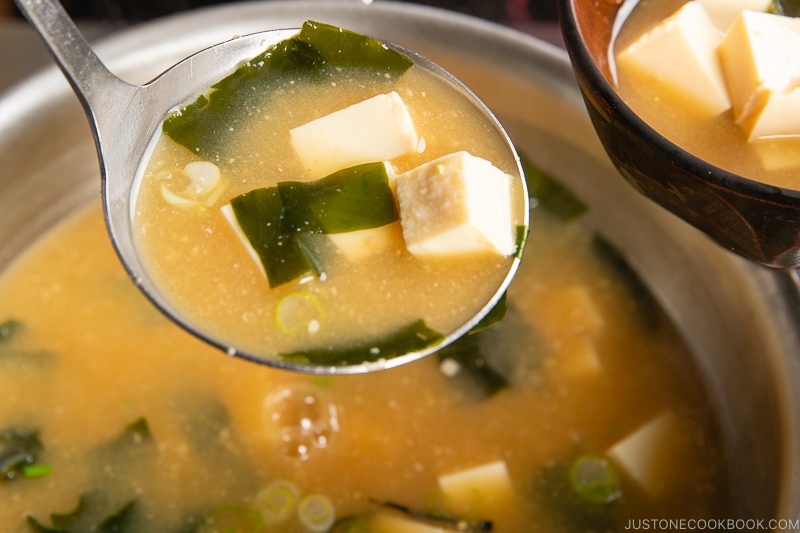
If your miso soup is no longer warm, reheat it until simmering (190°F/88°C) and NEVER boil it. Miso soup will lose its flavor and aroma (nothing to do with probiotics—see below).
If you are reheating the leftover miso soup, add about 1 tablespoon (18 g) of miso to the soup (you may need to add more dashi or water). This way, you can enjoy the warm aroma of freshly dissolved miso.
💡Pro Tip
There’s a misconception that boiling miso soup will kill probiotics. However, probiotics are destroyed when the temperature of miso soup is above 140°F (60°C). Rather, the warning for not boiling miso soup is to preserve its flavor and aroma. The Japanese don’t treat miso soup as merely a source of probiotics. To reap the probiotic benefits, use miso in salad dressing and dipping sauces. Miso soup is chock full of protein, fiber, and minerals unaffected by heat!
How to Store Miso Soup
In general, it‘s best to consume all the miso soup right away because it will lose its aroma and taste as time passes. If you like to keep the leftover, let your miso soup cool to room temperature (up to 4 hours; any longer and it will spoil) and then refrigerate. You can keep it for up to 2 days in the refrigerator. You can freeze miso soup for up to 2 weeks. However, you have to remove the tofu before freezing as the texture will change.
To reheat, see the above section for reheating tips.
If you want to make a big batch to store for later, it‘s best to refrigerate the soup without adding the miso. When ready to use, add the miso paste only for the portion you need.
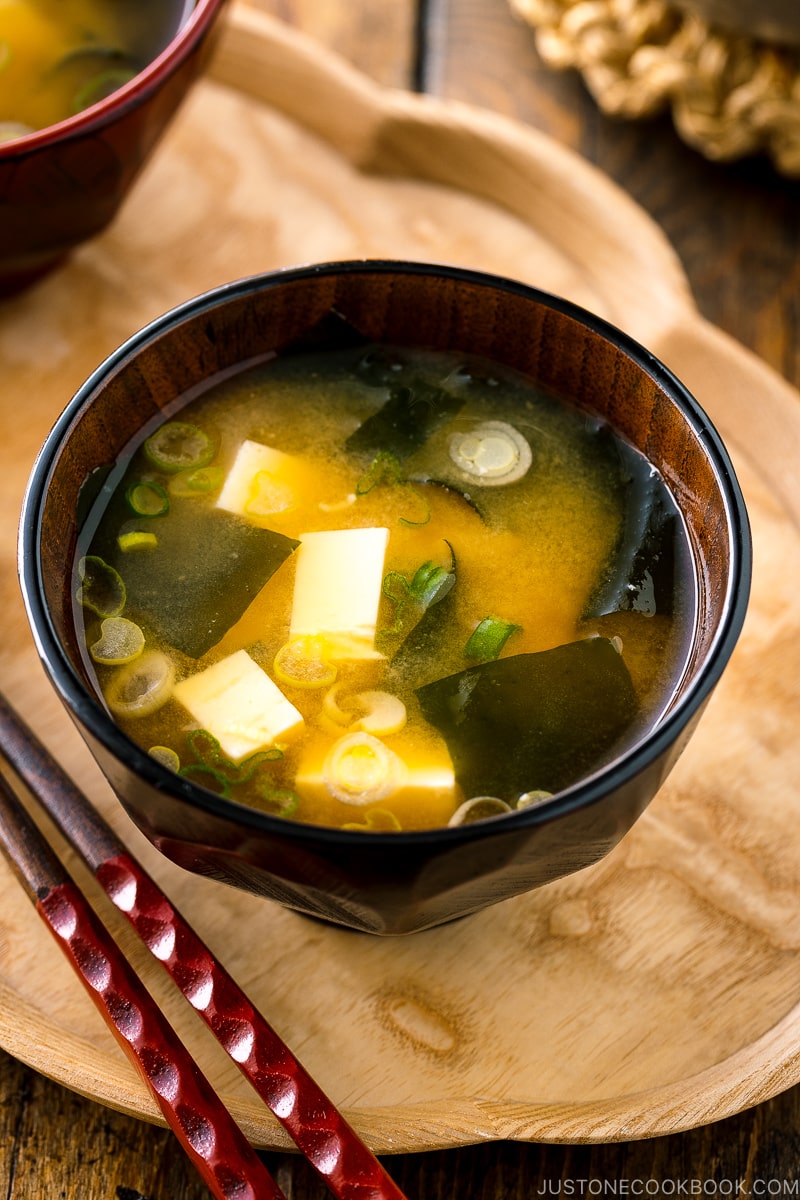
Key Points to Remember
- You can make a big batch of dashi and keep it in the refrigerator for 3-5 days.
- Add miso right before serving. Not mealtime yet? Wait until you’re ready to serve.
- Bring dashi to a slow boil (205°F/96°C), turn off the stove’s heat, and add miso. This temperature is the most fragrant stage for miso soup. By the time you enjoy the soup, it is an ideal temperature (167ºF or 75ºC) for drinking.
- Use one tablespoon per cup or miso soup bowl (200ml) and adjust the taste. Dissolve miso first in a ladle, a separate bowl, or a miso strainer to avoid clumps in the soup.
- Add tofu after dissolving miso (as well as wakame and green onion).
- Never boil miso soup because it loses its flavor and aroma.
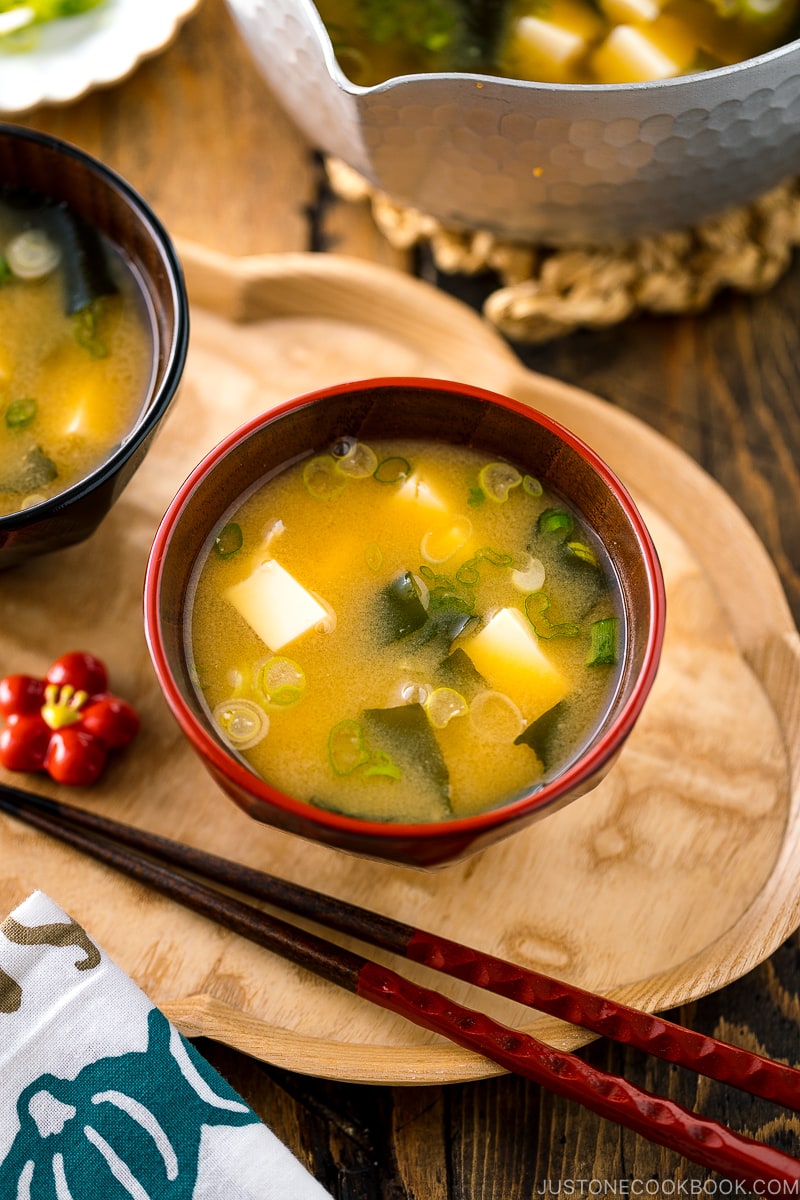
Advanced: Incorporating Other Ingredients in Miso Soup
This is a bit more advanced topic, but I’d like to give a quick introduction to it here.
If you’re using root vegetables, place them in cold dashi and cook until they become tender, approximately 10-15 minutes, depending on the vegetable’s density and cut.
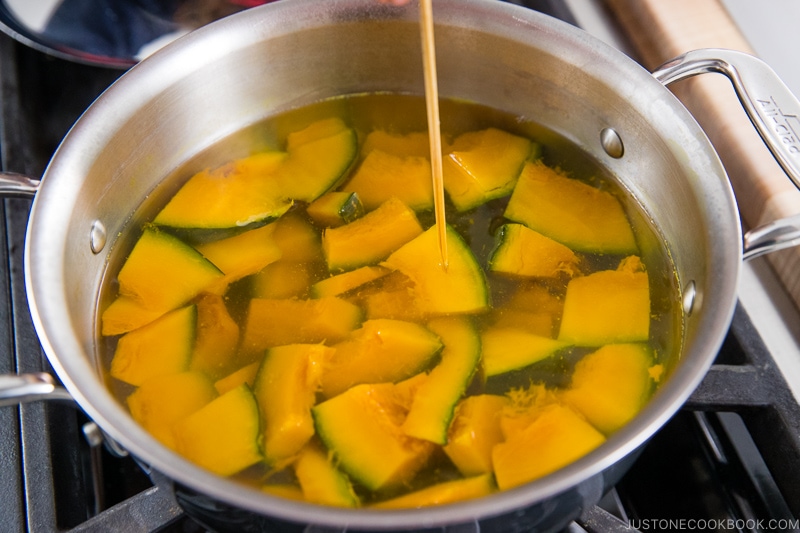
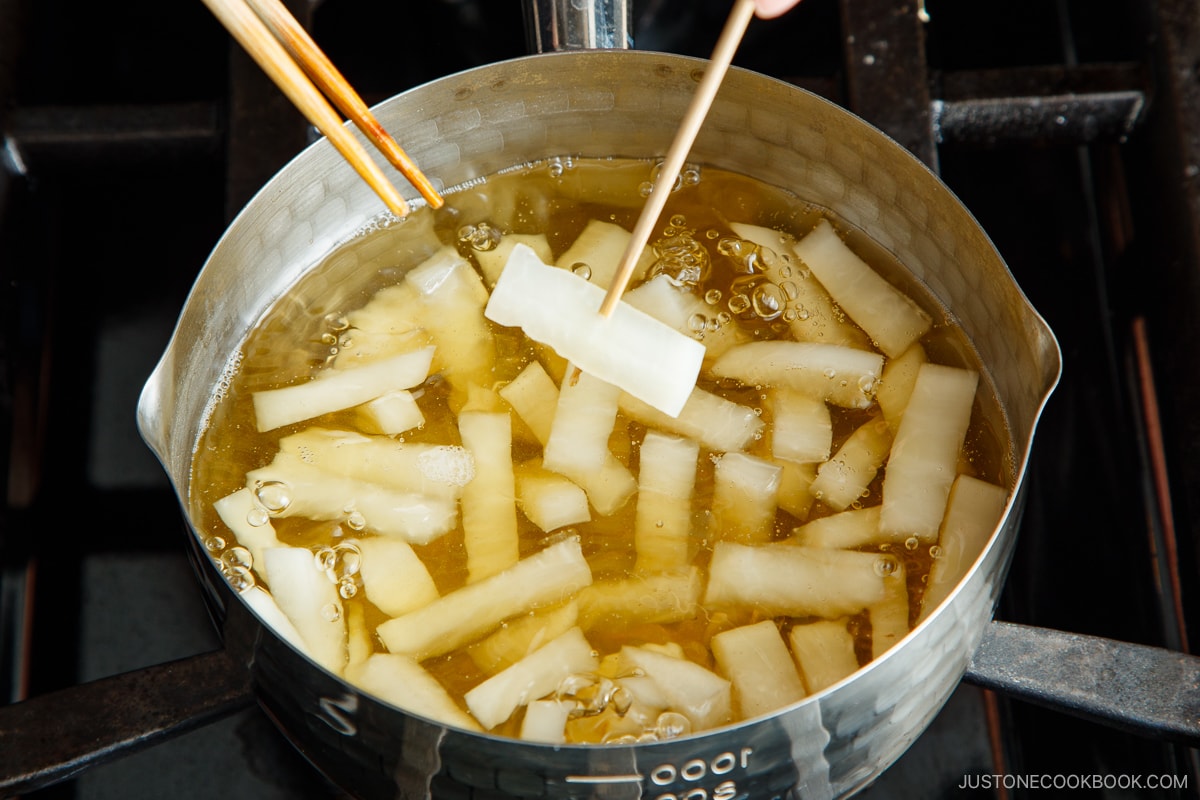
For leafy vegetables and mushrooms, you can add them to already simmering dashi (with or without other cooked ingredients) and cook for a few minutes.
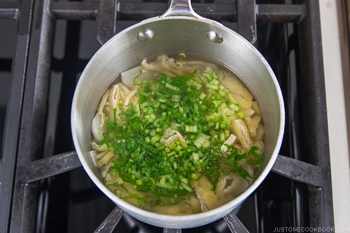
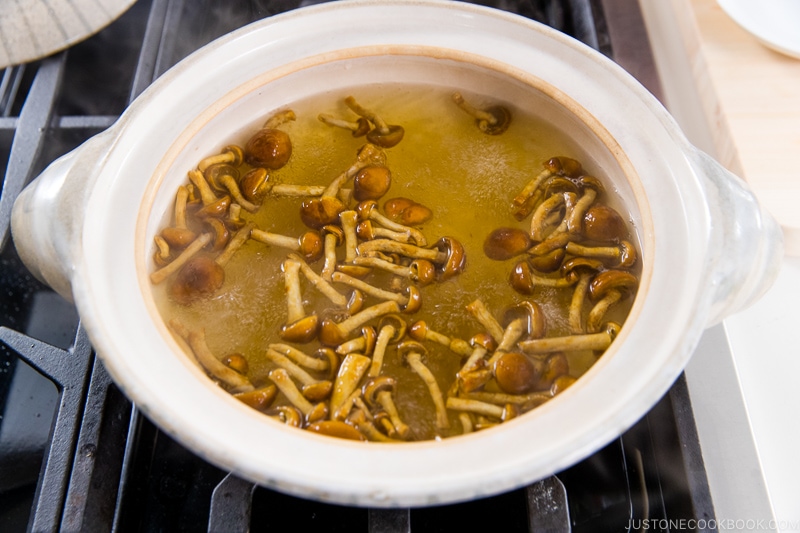
Besides tofu and wakame seaweed, you can add seasonal and year-round ingredients to your miso soup. Check out a collection of seasonal miso soup recipes on Just One Cookbook.
Health Benefits of Miso Soup
Japanese people drink miso soup daily, as we believe this delicious and healing soup is a gateway to excellent health. Much like green tea, you can say miso soup is the elixir of the Japanese diet. Here are just some of the health benefits of miso soup:
- Good source of nutrients. Miso is rich in essential minerals such as copper, manganese, protein, Vitamin K, and zinc. Therefore, drinking a bowl of miso soup daily is like taking a natural supplement for your health.
- Good for bones. Miso soup provides many bone-building minerals like calcium, magnesium, and manganese, which help to reduce the risk of developing osteoporosis.
- Improve heart health. The natural compounds in miso, including Vitamin K2, linoleic acid, and saponin, are known to reduce the risk of heart disease and lower cholesterol.
To fully enjoy the fantastic health benefits of miso soup, make your own miso soup. Instant miso soup may not be as beneficial, as it often contains higher sodium and additional preservatives. However, some reputable brands are available, so be sure to read the label.
Now that you’ve learned how to make miso soup at home, I hope you enjoy this nourishing soup every day!
Popular Miso Soup Recipes
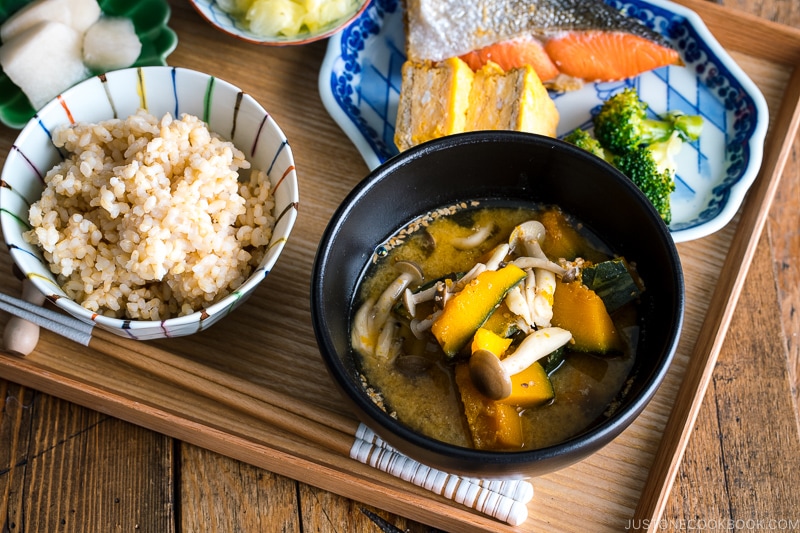
- Homemade Instant Miso Soup
- Vegan Miso Soup
- Vegetable Miso Soup
- Kabocha Miso Soup
- Tonjiru (Pork & Vegetable Miso Soup)
- Clam Soup (Asari Miso Soup)
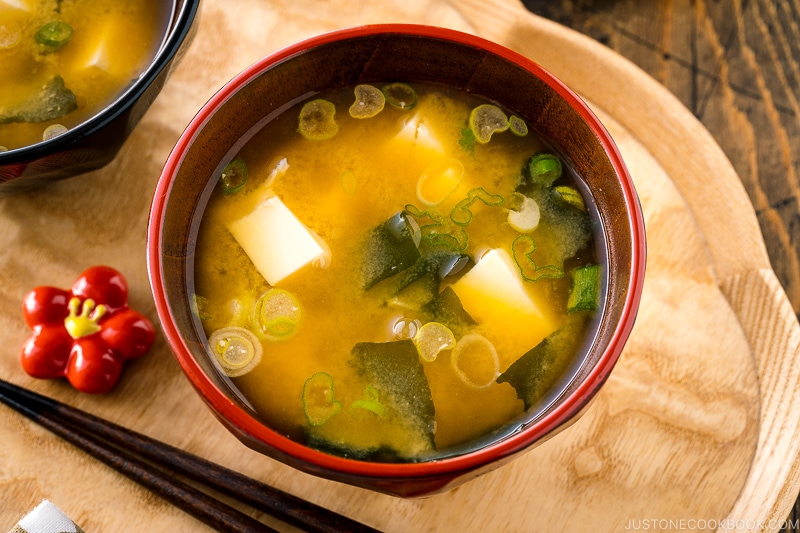
Wish to learn more about Japanese cooking? Sign up for our free newsletter to receive cooking tips & recipe updates! And stay in touch with me on Facebook, Pinterest, YouTube, and Instagram.
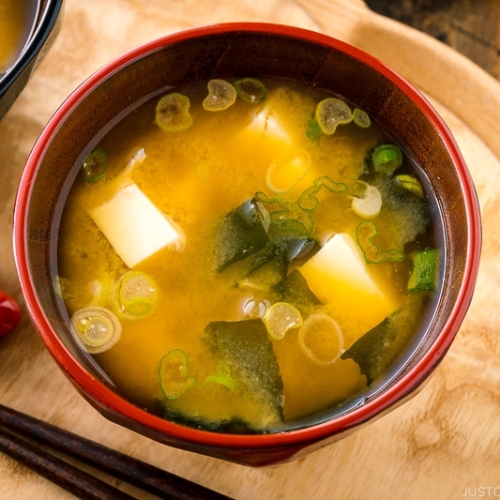
Homemade Miso Soup with Tofu
Video
Ingredients
For the Dashi (makes a scant 4 cups)
- 4 cups water
- 1 piece kombu (dried kelp) (⅓ oz, 10 g per piece; 4 x 4 inches or 10 x 10 cm)
- 1 cup katsuobushi (dried bonito flakes) (packed; I used a loosely packed 3 cups in the video for stronger flavor)
For the Miso Soup
- 7 oz soft/silken tofu (kinugoshi dofu)
- 4–5 Tbsp miso (use 1 Tbsp, 18 g for every 1 cup, 240 ml of dashi)
- 1 Tbsp dried wakame seaweed
- 1 green onion/scallion
Instructions
- Before we start… I make Awase Dashi with kombu and katsuobushi in this recipe. You can also make dashi with a dashi packet or powder. For vegan/vegetarian, make the Kombu Dashi I showed below or make Vegan Dashi with kombu and dried shiitake mushrooms.

- Gather all the ingredients.

- Cut 1 green onion/scallion into thin rounds.

To Make the Dashi (can make in advance)
- Add 4 cups water and 1 piece kombu (dried kelp) to a medium saucepan. If you have time, soak the kombu in water for 30 minutes. NEVER wash kombu and do not remove the white substance—that’s umami! These days, it‘s pretty clean, so just make sure there are no dirt particles.

- SLOWLY bring it to a boil (about 10 minutes) on medium-low heat so you can extract as much umami from the kombu as possible. Right before the stock boils, remove the kombu and set it aside for another use. (If you leave the kombu, it gets slimy and yields a bitter taste.) Now, what you have is Kombu Dashi. If you’re vegetarian/vegan, use this kombu dashi for your miso soup.

- If you‘re not vegetarian/vegan, add 1 cup katsuobushi (dried bonito flakes) to the kombu dashi and bring it back to a boil again. Once the dashi is boiling, reduce the heat, simmer for just 30 seconds.

- Turn off the heat and let the katsuobushi sink to the bottom, about 10 minutes. Then, strain through a fine-mesh sieve.

- Now you have roughly 4 cups of Awase Dashi. You can store the dashi in the refrigerator for up to 3–5 days and in the freezer for up to 2 weeks. Reserve the spent katsuobushi and repurpose it; see the suggested recipes that follow at the end of the instructions.

To Make the Miso Soup
- Add the dashi to the saucepan. If you are using dashi from the refrigerator, bring it to a slow boil (205°F/96°C) over medium heat and turn off the heat.

- Add 4–5 Tbsp miso. Put the miso in a ladle, slowly add the dashi into the ladle, and stir with chopsticks to dissolve completely. Here, I‘m using a miso muddler. If you accidentally add too much miso, dilute the miso soup with dashi (or water).

- Here, I‘m using a fine-mesh miso strainer, which helps you dissolve the miso faster. After dissolving the miso in the strainer, you may see rice koji (especially when it‘s koji miso). It‘s up to you if you want to include it in the miso soup or discard it (personal preference).

- Cut 7 oz soft/silken tofu (kinugoshi dofu) into ½-inch (1.3 cm) cubes and add to the miso soup. Tip: Add the tofu after the miso is completely dissolved; otherwise, you might break the tofu when stirring in the miso. Note: It is very common to cut tofu on your palm in Japan. However, I recommend using a cutting board if you have never done this.

- Add 1 Tbsp dried wakame seaweed and the chopped green onions to the pot right before serving to keep their fresh fragrance and color. Tip: If you worry about salt intake, I recommend rehydrating the dried wakame in a separate bowl of water to get rid of the saltiness, instead of rehydrating it in the soup itself. If reheating, warm up the miso soup until it is just hot. NEVER BOIL miso soup because it loses flavor and aroma.

To Serve
- Serve immediately. Place on the right side of the table setting; you can read about this in my post Ichiju Sansai (One Soup Three Dishes).

To Store
- In general, it‘s best to consume all the miso soup right away because it will lose its aroma and taste as time passes. Let your miso soup cool to room temperature (up to 4 hours; any longer and it will spoil) and then refrigerate. Keep for up to 2 days in the refrigerator. If you want to make a big batch to store for later, it‘s best to refrigerate the soup without adding the miso. When ready to use, add the miso only for the portion you need. You can freeze miso soup for up to 2 weeks. However, you have to remove the tofu before freezing as the texture will change.
To Reheat the Miso Soup
- Heat the miso soup in a pot over medium heat, but do not boil. Miso loses its nutrients, flavor, and aroma at high temperatures.
What to do with the spent katsuobushi and kombu?
- Save the spent kombu and katsuobushi in an airtight container and store it in the refrigerator for a week or in the freezer for up to a month.

- With the spent kombu, you can make Simmered Kombu (Kombu Tsukudani).

- You can also make Homemade Furikake (Rice Seasoning).

Nutrition
Editor’s Note: The post was originally published on Mar 3, 2011. The recipe was revised and updated on June 7, 2022. The post was updated with new images, a new video, and more helpful content on February 2, 2024.
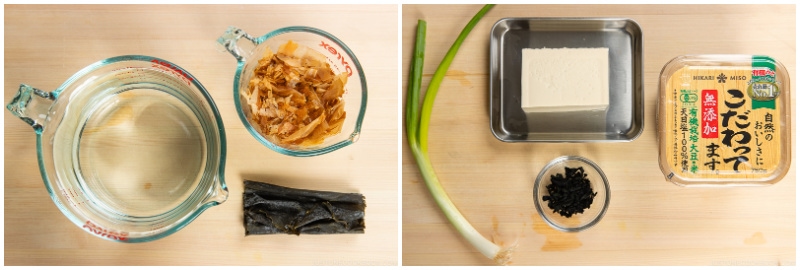
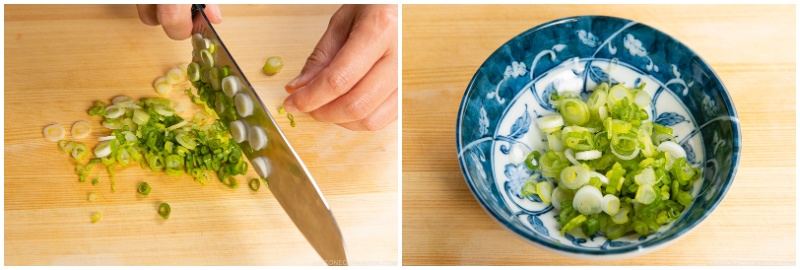
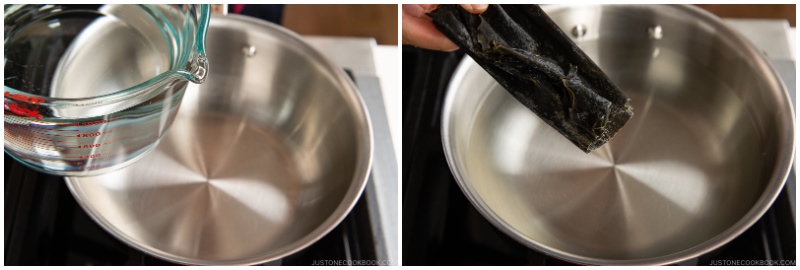
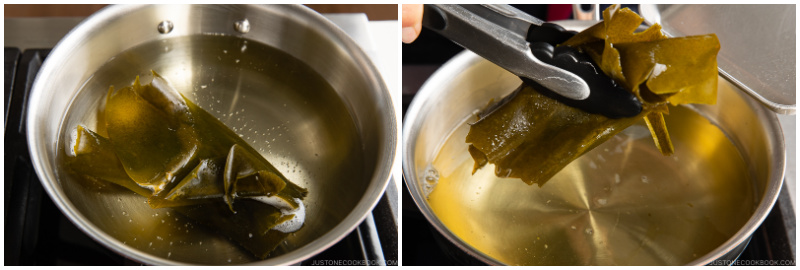
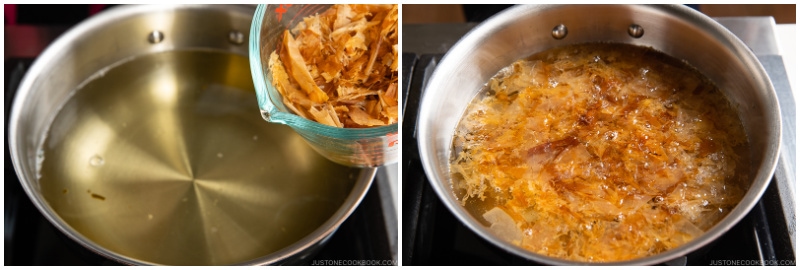
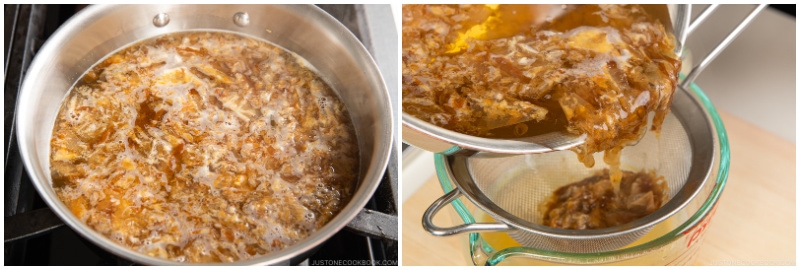
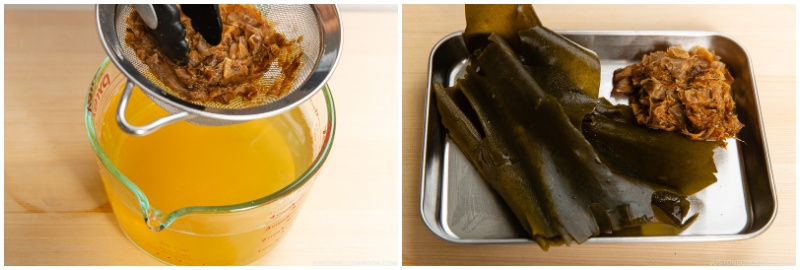
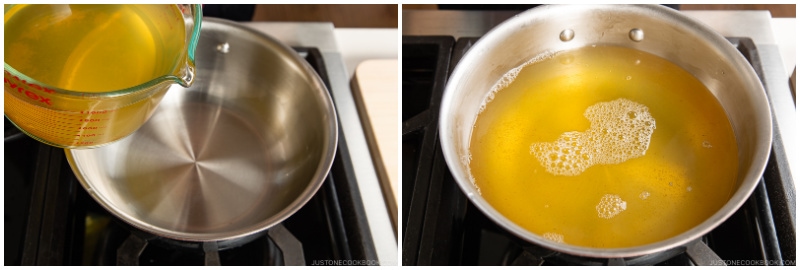
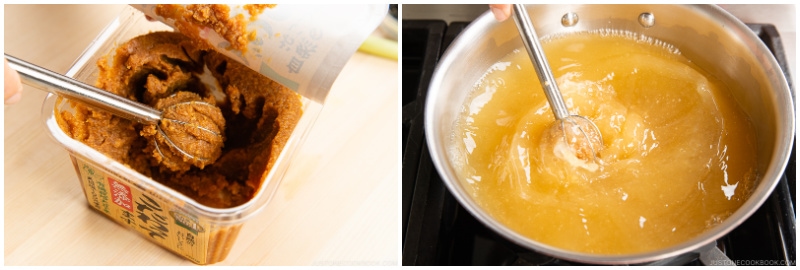
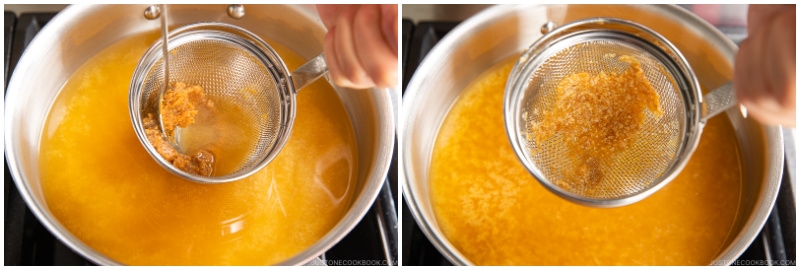

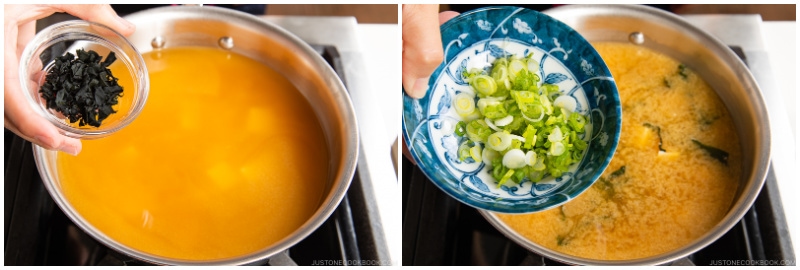
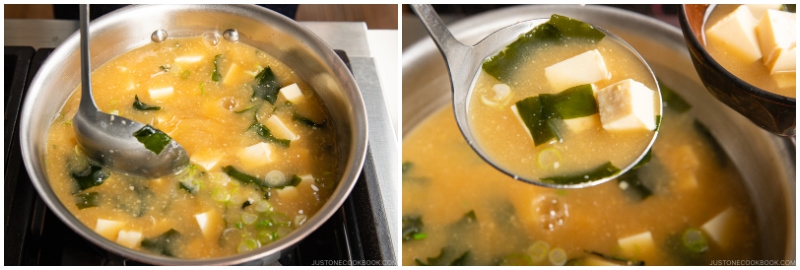
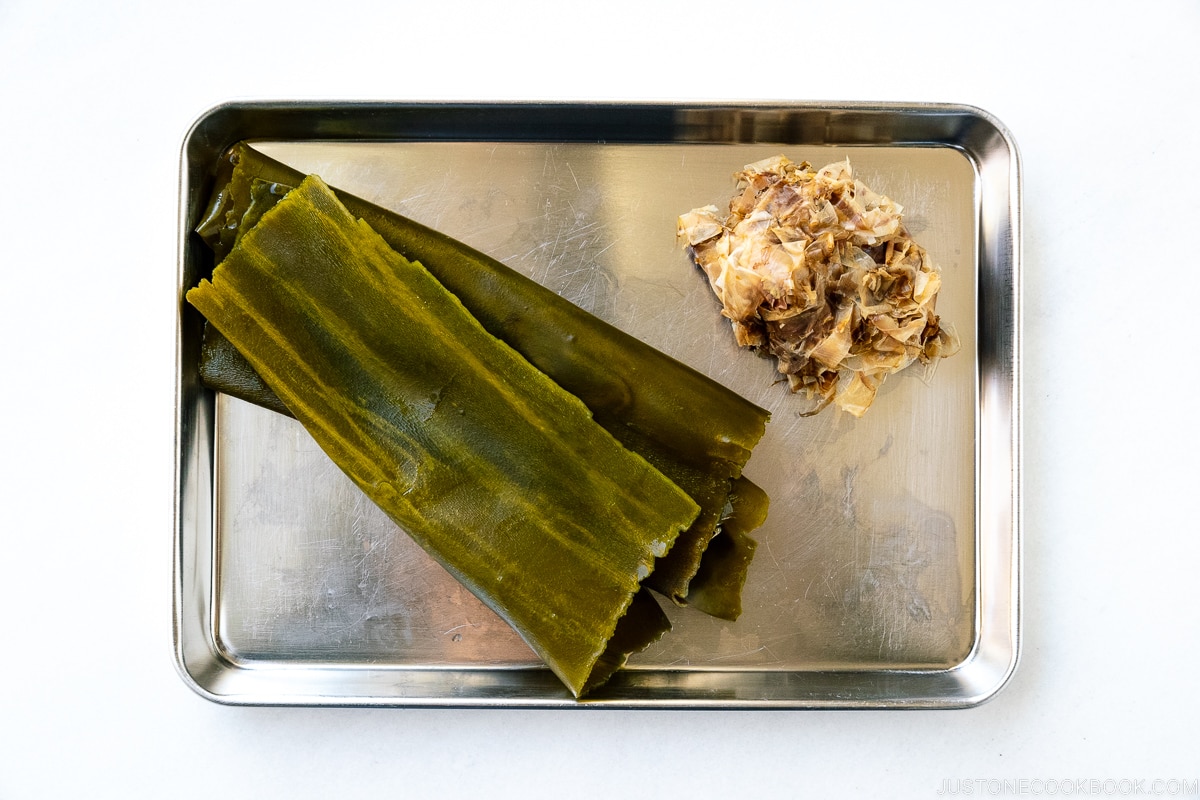
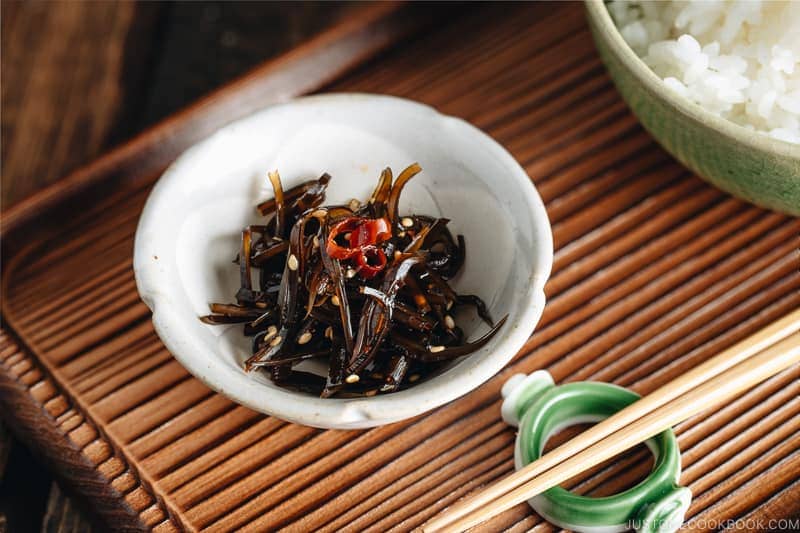
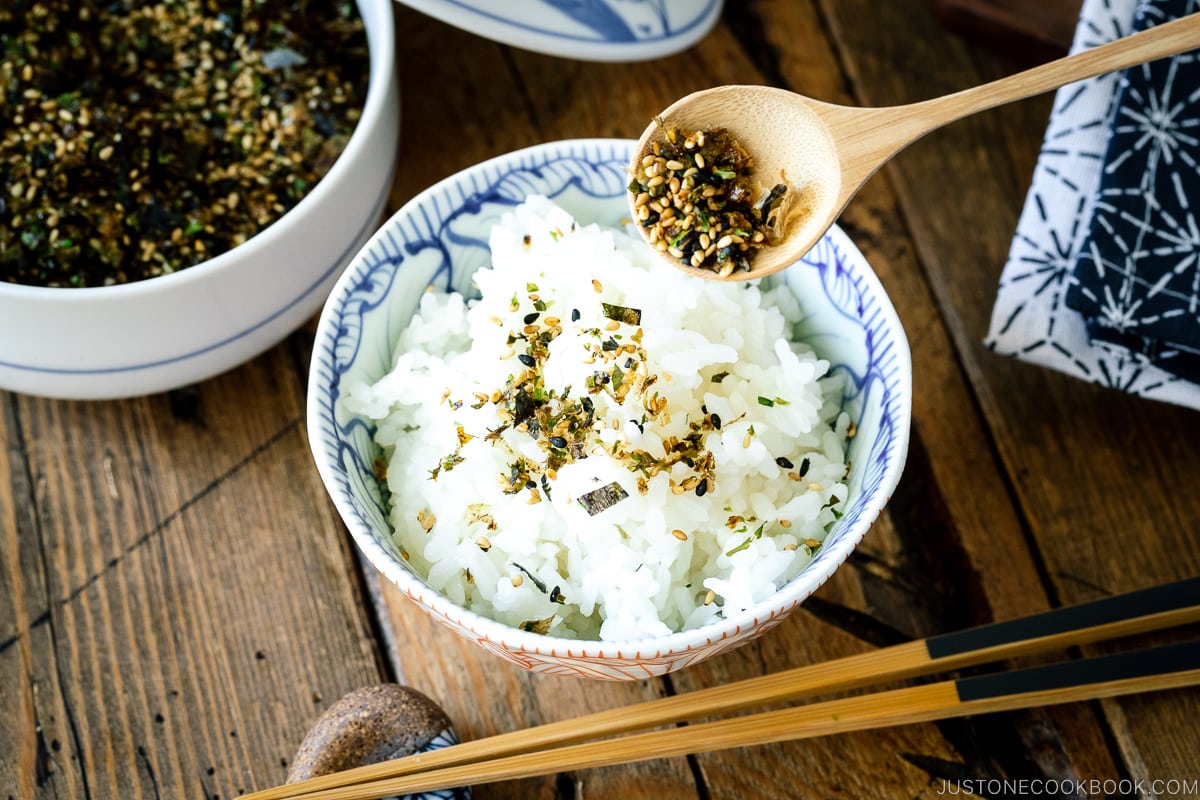










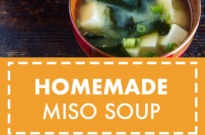
What do you do with the left over kombu in the miso soup? Can we eat it
Hello, Debby! Kombu used to produce dashi can be eaten. Nami recommends the following recipe for used Kombu. We hope that this helps!
https://www.justonecookbook.com/simmered-kombu-tsukudani/
Hi I love your website and want to thank you for generously putting all this out there for free!
I made the Miso Black Cod which was just amazing!
But when I made this miso soup is was so salty I couldn’t eat it. I was able to find all the ingredients at Nijiri even the Hikari Kodawattemasu miso paste. Maybe I used too much of that? Or would the seaweed be the culprit that I overused do you think?
Thanks again!
Hi, Charles! Thank you very much for trying Nami’s recipes!
It depends on the dried Wakame seaweed; you might need to prewash it. Please check the packages. It could be due to the overuse of Wakame. You can always add more miso later, so start with half the amount and see if you prefer the taste next time. We hope you can change the quantity to your liking and keep the recipe! 🫶🏻🙂
Maybe I overlooked a prior/posted comment/question. If so, apologies. But, for vegan dashi, how much (oz) dried shiitake to replace the bonito? 1:1 ?? The rest is easy/peasy. Nice recipe. Thanks!
Hello, Chuck. Thank you for trying Nami’s recipe!
For Vegan Dashi, please click the red letter “Vegan Dashi” on the recipe card. It will direct you to the vegan dashi recipe page. Ideally, two pieces of dried Shiitake mushrooms are used for every 4 cups of water. But you may add more if you like. We hope this helps! 🙂
A bit embarrassed to admit that I never knew this was the soup they serve at teppanyaki restaurants here in the US. Thank you for sharing this Recipe; I always loved it, and it’s great that I can just make it myself now.
Hi, Troy! We’re pleased to hear you discovered this recipe!
Thank you for reading Nami’s post and trying out her recipe. We hope you can enjoy miso soup whenever you want!🥰
Hi Nami,
I was told by my acupuncturist that she wanted me to start consuming bone broth soup due to the medicinal ingredient of collagen which helps with making your bones, muscles and cartilage stronger as you age. (I am 73) I have been making bone broth in my brand new slow cooker and then it occurred to me, why not make miso? I made your recipe some time ago and have to say it’s best broth I ever had. Can miso soup withstand hours of slow cooking without compromising the flavor? There are lots of crock pots (slow cooker) miso broth recipes on the internet where they add everything you add, plus other vegetables like carrots, celery, onions, bok choy, soy sauce, garlic, ginger, mirin, mushrooms, turmeric, etc. but not dashi. It’s the dashi broth I want to make and was wondering if it can withstand simmering for hours, which is the way you make bone broth. The longer you cook the more collagen. Any information would be greatly appreciated. Thanks, kazy
Hello, Kazy! Thank you for taking the time to read Nami’s post and for your thoughtful comments!
If you plan to leave the miso soup in the crock pot for several hours, we recommend adding the miso right before serving for a more pronounced miso flavor.
In terms of Dashi, we do not recommend exceeding the cooking time specified. Because ingredients impart a bitter or slimy texture to the Dashi, the longer it is cooked, For more information on each type of Dashi, visit https://www.justonecookbook.com/how-to-make-dashi-jiru/.
We hope this was helpful!
I found the exact miso paste used in this recipe at my grocery store in Japan and just used a packet of awase dashi with no additives. It was great! These recipes are seriously helpful because of the recommendations of specific brands and types of ingredients to use. Otherwise I’d just use the dashiiri miso paste and call it a day, not knowing all the health benefits I was missing out on.
Hello, Angie! We’re glad Nami’s directions and recipe were informative.
Thank you so much for trying the recipe and providing such supportive feedback. Happy Cooking! 🤗
Wow, this is the best recipe post I have ever read. Thank you for so much detail
Hi K W, Wow! Thank you so much! Nami and all of us at JOC are so happy to hear your kind feedback.🥰
Happy Cooking!
Hi, there. I’m eager to try this version of Miso Soup, but am unable to find any miso paste in my local shops – even the big supermarket where I used to buy it! I know it’s hardly miso soup without the…er…miso – but what do you recommend as a substitute for miso paste?
Hello, Graham. Thank you so much for taking the time to read Nami’s post and try her recipes.
Unfortunately, there is no suitable substitute for Miso. You may flavor it with soy sauce or try a different soup, such as Osumashi.
https://www.justonecookbook.com/japanese-clear-soup/
Another recommendation is to look for Miso at online stores.
https://www.justonecookbook.com/online-shops-for-asian-ingredients-goods/
We hope this helps!
Now THAT is amazing! Thank you 🙂
Hi Reeze! Thank you so much for reading Nami’s post and trying her recipe!
We are glad to hear you enjoy Homemade Miso Soup. Happy Cooking! 🤗
My husband doesn’t like miso soup, including the miso soup we had last week at one of Denver’s top sushi restaurants. I had planned to make sushi for a dinner party we had last night (we have a great Japanese fish counter nearby) so I also bought the ingredients to make one of Nami’s miso recipes. My husband loved it!! (So did our guests and I.)
Hi Cheri, Nami and all of us at JOC are so happy to hear your husband now loves Miso soup! ☺️
Thank you so much for your kind feedback and for sharing the experience with us.
Happy Cooking!
This is my first time on your blog and I really enjoyed this post. I’m going to attempt to make the Dashi so I can then make the miso soup. Being a vegan this is a perfect soup for me to make at home. I’ve had it in restaurants of course and I do like it. Your photos are beautiful and your tutorials helpful. Thanks
Hi Judee, Thank you so much for reading Nami’s post and trying her recipe!
We hope you enjoy many recipes from our site. Happy Cooking!
I’ve made this from scratch a few times using your recipe and absolutely love it. I usually soak the Kombu overnight with a few dried shiitake mushrooms and then follow the rest of your recipe with the bonito flakes to make the dashi. I then thinly slice and add the mushrooms to the soup while making. Really, really good!
Hi Darrel! Thank you so much for taking the time to read Nami’s post and trying her recipe!
We are glad to hear you enjoyed homemade Miso Soup. Happy Cooking!
This was amazing. I now realize what umami means! I found all of the ingredients to make this exactly as written. The aroma after adding the katsuobushi was amazing! Walking into the kitchen while this was simmering, the aroma was intense and incredible. I even found the silken tofu and it worked so well in the miso soup. Thank you for this recipe. I’ll be making this again and again.
MSG was originally derived from seaweed/kelp/kombu. MSG is naturally found in many foods such as the ingredients that make dashi. Dashi tastes the way it does because of MSG.
If anyone is curious about MSG and umami, you can read more here:
https://www.justonecookbook.com/the-definitive-guide-to-umami/
We hope this helps! 🤗
Great article! More people should read this.
Thank you, Brian! We are glad to hear you enjoyed it.🤗
What if I want to make only 2 cups? Is the dosage for Kombu and dried bonito flakes the same as the recipe above?
Hi Methriks, Thank you so much for trying Nami’s recipe!
You can halve the ingredient for 2 cups of servings or prepare the Dashi as directed and reserve half for the next day, etc.
We hope this helps!